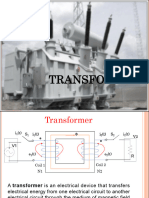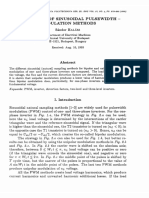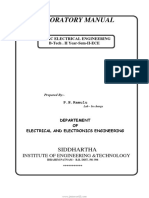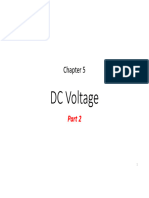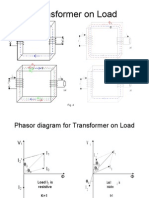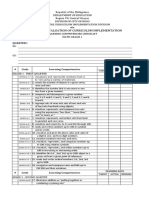Formulary
Formulary
Uploaded by
rayne101.23456Copyright:
Available Formats
Formulary
Formulary
Uploaded by
rayne101.23456Copyright
Available Formats
Share this document
Did you find this document useful?
Is this content inappropriate?
Copyright:
Available Formats
Formulary
Formulary
Uploaded by
rayne101.23456Copyright:
Available Formats
Fundamentals of electrical engineering
Hochschule für angewandte Wissenschaften
Ohm’s law Würzbug-Schweinfurt - Fakultät Elektrotechnik
I
U RI R U / I I U / R U
Symbol Quantity Unit Symbol
U I /G G I /U I U G
U Voltage Volt V
Electr. power: Work / energy: I Current Ampere A
P U I W P t U I t
R Resistance Ohm Ω
Power at resistor: Energy at resistor: G Conductivity Siemens S
P RI2 U2 / R W R I 2 t U 2 t / R P Power Watt W
W Work Joule J = Ws
resistivity: Temperature dependency:
R l / A ( ) 20C (1 20 20 2 ...) ρ Resistivity Ω·mm²/m
20C
Kirchhoff laws:
Current law: Voltage law:
U
N
U12 U 23 U 34 U 45 U 51 0
I
k 1
k I1 I 2 ... I N 0 U51 U12
{kl }M
kl
I1 I3 M
The sum of all currents in a node The sum of all voltages in a mesh is zero.
I2 is zero. U45 U23
U34
Prof. Dr.-Ing. Jan Hansmann Seite 1 Formulary
Fundamentals of electrical engineering
Hochschule für angewandte Wissenschaften
Series connection: Current devider: Würzbug-Schweinfurt - Fakultät Elektrotechnik
I1 R2 I2 R1
R1
R1 R2 RN I
I1
I R1 R2 I R1 R2
N
RGES R1 R2 ... RN Rk I1 R2 The currents are
I2 R2 reciprocal to the
k 1 I 2 R1 resistances.
Parallel connection: Voltage divider:
U1 R1 U2 R2
N U1 U2
1
1 U R1 R2 U R1 R2
RGES R1 R2
k 1 Rk
U1 R1 The voltages are
RN
R1
R2
R3
proportional to the
1 U U 2 R2
RGES resistances.
1 1 1
... Star to delta conversion
R1 R2 RN
R1
Two resistors: R1 R2
RGES
R1 R2
Source conversion: R23
Ri R12 R31 R1 R 2
R1 R12 R1 R 2
Uq = Iq · Ri R12 R 23 R31 R3
Iq
R 23 R12 R 2 R3
Ri R2 R 23 R 2 R3
Uq R12 R 23 R31 R1
Iq = Uq / Ri
R31 R 23 R3 R1
R3 R31 R3 R1
R12 R 23 R31 R2
Prof. Dr.-Ing. Jan Hansmann Seite 2 Formulary
Fundamentals of electrical engineering
Hochschule für angewandte Wissenschaften
Circuit analysis: Nodal voltage analysis:
Würzbug-Schweinfurt - Fakultät Elektrotechnik
Step 1: conversion of voltage sources in current sources
U13
U1 U3 Step 2: reference (here U4 = 0)
ID GD Step 3: KCL for nodes
M3
IA M2 IC Node U1: – Iq1 – GD·U13 – GE·U14 – GA·U12 = 0
IE IF M1
Node U2: GA·U12 – GF·U23 – GB·U24 – Iq2 = 0
U12
GA U23 U14 GC
U34 Node U3: GD·U13 – Iq3 – GC·U34 + GF·U23 = 0
with Ukl = Uk – Ul
GF GE
Node U1: – (GD+GE+GA)·U1 + GA·U2 + GD·U3 = Iq1
U2 U4
Node U2: GA·U1 – (GA+GF+GB)·U2 + GF·U3 = Iq2
IB GB
Node U3: GD·U1 + GF·U2 – (GD+GC+GF)·U3 = Iq3
U24
Matrix form:
Iq1 Iq2 Iq3
(GD GE G A ) GA GD U1 I q1
G A (G A G F G B ) G F U 2 I q 2
Kirchhoffsch laws:
GD GF (GD GC GF ) U 3 I q 3
Node U1: – Iq1 – ID – IE – IA = 0
IA – IF – IB – Iq2 = 0 Y11 Y12 Y13 U1 I q1 Y: Admittance matrix
Node U2:
Node U3: ID – Iq3 – IC + IF = 0 12
Y Y22 Y23 U 2 I q 2
𝑼: Vector with node voltages
Y 𝑰Ԧ: Vector with current sources
Mesh M1: IF / GF + IC / GC – IB / GB = 0 13 Y23 Y33 U 3 I q 3 Ik: Sum of all currents at node k.
Mesh M2: ID / GD – IF / GF – IA / GA = 0
Mesh M3: ID / GD + IC / GC – IB / GB – IA / GA = 0
Y 𝑼 𝑰Ԧ
6 equations and 6 unknowns 3 equations and 3 unknowns
IA, IB, IC, ID, IE and IF U1, U2 und U3
Prof. Dr.-Ing. Jan Hansmann Seite 3 Formulary
Fundamentals of electrical engineering
Hochschule für angewandte Wissenschaften
AC
Würzbug-Schweinfurt - Fakultät Elektrotechnik
… time domain … … complex numbers … … phasor …
Voltage u (t ) uˆ sin( t U ) u (t ) uˆ e j( t U ) uˆ e j t
Current i (t ) iˆ sin( t I ) i (t ) iˆ e j( t I ) iˆ e j t
Im
u
ρU
RMS û iˆ U
û iˆ i
U Eff I Eff I
2 2 2 ρI
Effective value
2
Re
Impedance Admittance
(complex resistance) (complex conductivityt)
uˆ iˆ Z uˆ iˆ / Y
Ohmic
resistor u (t ) R i (t ) Z R 1/ G R Y R G 1/ R
Im Capacitor:
Current leads voltage
iC by 90°.
Inductor di 1
u (t ) L Z L j L YL u
dt j L iR
Re
Capacitor 1 1
C
u (t ) i (t ) dt ZC Y C j C Inductivity:
j C iL Voltage leads current
by 90°.
Prof. Dr.-Ing. Jan Hansmann Seite 4 Formulary
Fundamentals of electrical engineering
Hochschule für angewandte Wissenschaften
Instantaneous Power:
*
p(t ) u (t ) i (t ) Re U I Re U I e 2 j t I, U, and I Eff - Fakultät
with RMS values ofWürzbug-Schweinfurt I , U Eff U
Elektrotechnik
Complex power Real power Apparent power Reactive power
S U I P Re S S S Q Im S
*
Power:
Ohmic resistor
S R R I Eff
2
PR R I Eff
2
S R R I Eff
2
QR 0
Inductor
S L j L I Eff
2
PL 0 S L L I Eff
2
QL L I Eff
2
2 2 2
Capacitor I Eff I Eff I Eff
SC PC 0 SC QC
j C C C
Gain: Example: lowpass 2
ADB ,Tiefpass 10 log10 1 2 dB
0
uˆa U a , Eff
A A0
uˆe U e , Eff L 0dB Corner frequency
ue(t) R ua(t) -10dB
-20dB
R
0
-20dB/Decade
AdB 10 log 10 A dB 2
L
-30dB
-40dB
uˆ U R 1 -50dB Pass band Block band
20 log10 a dB A a -60dB
uˆe Ue j L R 1 2 / 02
0.01ω0 0.1ω0 ω0 10ω0 100ω0
Prof. Dr.-Ing. Jan Hansmann Seite 5 Formulary
Fundamentals of electrical engineering
Three-phase-circuits: U1 Hochschule für angewandte Wissenschaften
U1 Würzbug-Schweinfurt I-1Fakultät Elektrotechnik
L1
I1 U 2 U 1 e -j120 U31 U12
L1 U1 U12 U31 UStr1 UStr3
U 3 U 1 e -j240 U3 U2
U1 U12 U31 U23
UStr1 U1 U 2 U 3 0 Phase voltage
UStr2 I2
L2
I2
U 12 U 1 U 2 U 1 3 e j30
U2 U23 I3 UStr2
L2 L3
U2 U23 I3 UStr3 U 23 U 2 U 3 U 1 3 e -j90 U 12 e -j120 U3
L3 N I 1 I 12 I 31
U3 U 31 U 3 U 1 U 1 3 e j150 U 12 e -j240
N Line voltages I 2 I 23 I 12
U 12 U 23 U 31 0
I 3 I 31 I 23
U Str1 U 1 I Str1 I 1 U 1 / Z 1 U U Ph U 1 U 2 U 3
star
U Str1 U 12 I Str1 I 12 U 12 / Z 12
U Str 2 U 2 I Str 2 I 2 U 2 / Z 2
delta U U 12 U 23 U 31 U Str 2 U 23 I Str 2 I 23 U 23 / Z 23
U Str 3 U 3 I Str 3 I 3 U 3 / Z 3
nominal U N U 3 U U Str 3 U 31 I Str 3 I 31 U 31 / Z 31
I1
L1
Symmetric load: I 2 I 1 e -j120
Sternschaltung U1 U12 U31
Z Z1 Z 2 Z 3 I 3 I 1 e -j240
mit offenen UStr1 Z Z Str1 Z Str 2 Z Str 3 I1 I 2 I 3 0
Sternpunkt: UStr2
Z 3 Z I 12 I 23 I 31 0
I2
L2
U2 U23 I3 UStr3 line I Str I 12 I 23 I 31
L3
U3 U0N phase I AL I Ph I 1 I 2 I 3 3 I Str
N
U1 U U power:
I Str1 I 1 (U 1 U 0 N ) / Z Str1 2 3
S U Str1 I Str1 U Str 2 I Str 2 U Str 3 I Str 3 3 U Str1 I Str1
* * * *
Z Z Str 2 Z Str 3
I Str 2 I 2 (U 2 U 0 N ) / Z Str 2 U 0N Str1 sym.
1 1 1
I Str 3 I 3 (U 3 U 0 N ) / Z Str 3 S 3 U Str I Str , P 3 U Str I Str cos , Q 3 U Str I Str sin
Z Str1 Z Str 2 Z Str 3 sym. sym. sym.
Prof. Dr.-Ing. Jan Hansmann Seite 6 Formulary
You might also like
- Structural Behaviour of Geopolymer Slab Panels: S.Veeraraghavan Mr.R.SankaranarayananDocument4 pagesStructural Behaviour of Geopolymer Slab Panels: S.Veeraraghavan Mr.R.SankaranarayananheminNo ratings yet
- Electromotive Force Resistor Circuits Kirchoff's Rules RC CircuitsDocument19 pagesElectromotive Force Resistor Circuits Kirchoff's Rules RC CircuitsSyed Anas SohailNo ratings yet
- 351 - 27435 - EE231 - 2021 - 1 - 2 - 1 - 0 2 EE321 Lec2 KCL KVLDocument27 pages351 - 27435 - EE231 - 2021 - 1 - 2 - 1 - 0 2 EE321 Lec2 KCL KVLv2nxy9jrcyNo ratings yet
- Chapter11 - Electricity WorkshopDocument12 pagesChapter11 - Electricity Workshopazyad8246No ratings yet
- Electrical Technology Lab: Dronacharya College of Engineering Khentawas, Gurgaon - 123506Document46 pagesElectrical Technology Lab: Dronacharya College of Engineering Khentawas, Gurgaon - 123506Shreyansh RajNo ratings yet
- Electrical Technology 08082016Document46 pagesElectrical Technology 08082016AkNo ratings yet
- Electrical Fundamentals -3Document143 pagesElectrical Fundamentals -3hafidhadam2002No ratings yet
- Copy of Electrodynamic WattmeterDocument19 pagesCopy of Electrodynamic WattmeterArijit PaulNo ratings yet
- Part A Mesh TechniqueDocument10 pagesPart A Mesh TechniqueAhsan ShabirNo ratings yet
- Unit 1 DC Network TheoremsDocument20 pagesUnit 1 DC Network TheoremsVedansh JakhmolaNo ratings yet
- 2 Simple DC CCTDocument54 pages2 Simple DC CCTiman qasidahNo ratings yet
- Dry Transformer TrainingDocument83 pagesDry Transformer TrainingHilde GoebelNo ratings yet
- COURS Dipole RL PCDocument10 pagesCOURS Dipole RL PCpeniela RatoavinirinaNo ratings yet
- Bsaic of RsistorsDocument33 pagesBsaic of Rsistorsmohamed shabbanNo ratings yet
- X11 Physics P14-EMI/AC Worksheet U Solution: 100 Cos 100 Sin 120 200 Sin 60 60 100Document4 pagesX11 Physics P14-EMI/AC Worksheet U Solution: 100 Cos 100 Sin 120 200 Sin 60 60 100Loka lakshitha S.RNo ratings yet
- Week 3Document39 pagesWeek 3lizzyliza1991No ratings yet
- Disha Publication Electrical Concept Notes With Exercies Electrical MachinesDocument64 pagesDisha Publication Electrical Concept Notes With Exercies Electrical MachinesRal Meena100% (1)
- Half-Wave Rectifier - VerstudDocument21 pagesHalf-Wave Rectifier - VerstudLIEW HUI FANG UNIMAPNo ratings yet
- Half-Wave RectifierDocument21 pagesHalf-Wave RectifierMuhammad Anaz'sNo ratings yet
- DC CircuitsDocument9 pagesDC Circuitske.No ratings yet
- 2 Simple DC CCTDocument56 pages2 Simple DC CCTMohamaadNo ratings yet
- Lecture 6: Circuits (Cont.), Kirchoff's Laws, and Nodal AnalysisDocument8 pagesLecture 6: Circuits (Cont.), Kirchoff's Laws, and Nodal AnalysisAmir YonanNo ratings yet
- EE2102 Lecture Notes-1Document21 pagesEE2102 Lecture Notes-1princesantanu18No ratings yet
- Review Seluruh Materi Transformator: Teknik Elektro Universitas GunadarmaDocument46 pagesReview Seluruh Materi Transformator: Teknik Elektro Universitas GunadarmabayuindraNo ratings yet
- UntitledDocument27 pagesUntitledDaniel SetiawanNo ratings yet
- 8 - 2 - TransformersDocument31 pages8 - 2 - TransformersNikhil PatelNo ratings yet
- TransformersDocument6 pagesTransformersanuradhaNo ratings yet
- Basic Electrical & Electronics Engineering: Lecture Notes ONDocument12 pagesBasic Electrical & Electronics Engineering: Lecture Notes ONKatiyar RahulNo ratings yet
- Lect 9 f03Document33 pagesLect 9 f03jyothsnadevibandojuNo ratings yet
- Comparison of Sinusoidal Pulsewidth - Modulation MethodsDocument18 pagesComparison of Sinusoidal Pulsewidth - Modulation MethodsMárcio SilvaNo ratings yet
- TransformerDocument25 pagesTransformerTHE PIVOTALNo ratings yet
- Lecture 9 - Transformer Tests PDFDocument15 pagesLecture 9 - Transformer Tests PDFCharlotte BNo ratings yet
- EEE 2106Document48 pagesEEE 2106Humayra Tabassum EkraNo ratings yet
- Ac Circuits: Robertson A. LabanDocument42 pagesAc Circuits: Robertson A. LabanBenedict TumlosNo ratings yet
- Unit 1 DC Network TheoremsDocument53 pagesUnit 1 DC Network TheoremsHardik EmpireNo ratings yet
- 6 TransformerDocument10 pages6 TransformerYash BhongadeNo ratings yet
- BRP Bee Module 1Document15 pagesBRP Bee Module 1priyaNo ratings yet
- Lecture03 - ResistanceDocument34 pagesLecture03 - Resistanceharsh9515311No ratings yet
- Benefits of AC-motorDocument12 pagesBenefits of AC-motorPuneet JoshiNo ratings yet
- ELECTRICITY Cheat Card 2 MinDocument1 pageELECTRICITY Cheat Card 2 Minoba182051No ratings yet
- Class 2 - Active & Passive ElementsDocument25 pagesClass 2 - Active & Passive ElementsSwayam Tejas PadhyNo ratings yet
- UntitledDocument38 pagesUntitledDaniel SetiawanNo ratings yet
- Study of R-L-C Series CircuitDocument8 pagesStudy of R-L-C Series Circuitr21745566No ratings yet
- Chapter1-2 - Single Phase TransformerDocument53 pagesChapter1-2 - Single Phase TransformerswastikamohantyNo ratings yet
- Islamic University of Technology (Iut)Document2 pagesIslamic University of Technology (Iut)shiamNo ratings yet
- Phy152 Lecture NoteDocument9 pagesPhy152 Lecture NoteAbubakar Olarewaju khaleedNo ratings yet
- Unit V: AC Voltage Controller and CycloconverterDocument17 pagesUnit V: AC Voltage Controller and CycloconverterAkshaya Hariharan100% (1)
- BEEE - Experiment 3 (7)Document3 pagesBEEE - Experiment 3 (7)anshumanjaiswal809No ratings yet
- Basic Electrical Engineering PDFDocument37 pagesBasic Electrical Engineering PDFTeja BhogadiNo ratings yet
- Adi Alarma Incendiu Automatizare Fire AlarmDocument4 pagesAdi Alarma Incendiu Automatizare Fire AlarmbiotekyNo ratings yet
- 2 1 Eee 2188 PDFDocument36 pages2 1 Eee 2188 PDFMOSIUR RAHMANNo ratings yet
- Utkarsh Physics Ac Project 2.0OOODocument20 pagesUtkarsh Physics Ac Project 2.0OOOT VpNo ratings yet
- G9 - Physics - DC Voltage Part 2Document17 pagesG9 - Physics - DC Voltage Part 2giovannichrabieh10No ratings yet
- Experiment 110-Kirchhoffs-LawsDocument5 pagesExperiment 110-Kirchhoffs-LawsKarl CastroNo ratings yet
- Transformer On LoadDocument14 pagesTransformer On Loadrajatxavier4u100% (1)
- Arus Listrik: Pertemuan Ke 5Document36 pagesArus Listrik: Pertemuan Ke 5Bagus Abi PNo ratings yet
- Electromagnetic ActuatorsDocument24 pagesElectromagnetic Actuatorsadanaspor100% (1)
- 1 Circuit TheoryDocument34 pages1 Circuit TheoryLove StrikeNo ratings yet
- 1 Circuit TheoryDocument34 pages1 Circuit TheoryFaris Abd HalimNo ratings yet
- Electro-Technique 2: TransformerDocument57 pagesElectro-Technique 2: TransformerAmmar Raman100% (1)
- Design of Electrical Circuits using Engineering Software ToolsFrom EverandDesign of Electrical Circuits using Engineering Software ToolsNo ratings yet
- IIT Bombay Unofficial LaTeX Beamer Presentation Template 1Document17 pagesIIT Bombay Unofficial LaTeX Beamer Presentation Template 1Yash Sanjay ShewaleNo ratings yet
- Rotor-Dynamics Analysis Process: Polar Moment of Inertia About The Axis of SpinDocument16 pagesRotor-Dynamics Analysis Process: Polar Moment of Inertia About The Axis of SpinpavanpppNo ratings yet
- Summer Vacation Class Time TableDocument3 pagesSummer Vacation Class Time TableAsraar BudyeNo ratings yet
- Gravitation: Chapter - 01Document96 pagesGravitation: Chapter - 01RICKNo ratings yet
- Calculation of Stiffness in Structural ElementsDocument20 pagesCalculation of Stiffness in Structural Elementsahmed11 engyemenNo ratings yet
- Bachelor Thesis Report FormatDocument4 pagesBachelor Thesis Report Formatmegansimmonskansascity100% (3)
- First-Principles Calculation On Dilute Magnetic AlDocument6 pagesFirst-Principles Calculation On Dilute Magnetic AlYasir SaeedNo ratings yet
- EE330 Digital Signal Processing: Discrete Time Signals and SystemsDocument17 pagesEE330 Digital Signal Processing: Discrete Time Signals and SystemsNihal AhmadNo ratings yet
- Mechanical BeltsDocument9 pagesMechanical BeltstorresgiovanniNo ratings yet
- Lab 4 Group 8Document9 pagesLab 4 Group 8Azam017 CrNo ratings yet
- Year 9 Exam RevisionDocument3 pagesYear 9 Exam Revisionxf4jk95mcdNo ratings yet
- EE8002 DEA QB All UnitsDocument7 pagesEE8002 DEA QB All Units5062-SANJAY RNo ratings yet
- Integral 2015Document385 pagesIntegral 2015Jeano CarlosNo ratings yet
- Thermal Properties of Matter CH11Document33 pagesThermal Properties of Matter CH11Rishab SharmaNo ratings yet
- Organic Spectroscopy and Chromatography by M Younas Third EditionDocument377 pagesOrganic Spectroscopy and Chromatography by M Younas Third EditionjoaoDjmsNo ratings yet
- ĐỒ THỊ logP hđồ thị môi chất lạnh đóDocument7 pagesĐỒ THỊ logP hđồ thị môi chất lạnh đóTrung Bùi QuốcNo ratings yet
- Spherical Shell-IgnouDocument14 pagesSpherical Shell-IgnouUBAID KHANNo ratings yet
- Válvulas Borboletas Posi FlateDocument4 pagesVálvulas Borboletas Posi FlateRodrigo MilaniNo ratings yet
- Lab Report Ohm's Law G2 PDFDocument7 pagesLab Report Ohm's Law G2 PDFjsdhkadkjasNo ratings yet
- AISC 14th Ed Design Examples - Spec CH JDocument22 pagesAISC 14th Ed Design Examples - Spec CH JAlex AfcNo ratings yet
- 8 Asat Syllabus 240118 190017Document1 page8 Asat Syllabus 240118 190017agentfrost2010No ratings yet
- ProNet Servo System DDocument21 pagesProNet Servo System DAntonio Marcos CarvalhoNo ratings yet
- Effect of Magnetic Fields On Growth and AntioxidanDocument8 pagesEffect of Magnetic Fields On Growth and AntioxidanKoko GamesNo ratings yet
- 2020 Learning Competencies Checklist (Ap)Document125 pages2020 Learning Competencies Checklist (Ap)Goodboy BatuigasNo ratings yet
- Thermody Lab About Egg Chuchu PDFDocument4 pagesThermody Lab About Egg Chuchu PDFGievel Enoroba LopezNo ratings yet
- Centre of Mass - Collision - (Step-4) - JEE-22-FinalDocument6 pagesCentre of Mass - Collision - (Step-4) - JEE-22-FinalAditya PahujaNo ratings yet
- Kritika DisseratationDocument42 pagesKritika DisseratationMridul GaurNo ratings yet
- Grade 8 Summative TestDocument2 pagesGrade 8 Summative TestJulie Ann Campollo-TalabonNo ratings yet
- Lesson 8 - Energy PotentialDocument12 pagesLesson 8 - Energy PotentialElijah AlcorezaNo ratings yet






















